The first installment of a new, ongoing 13th Dimension feature…
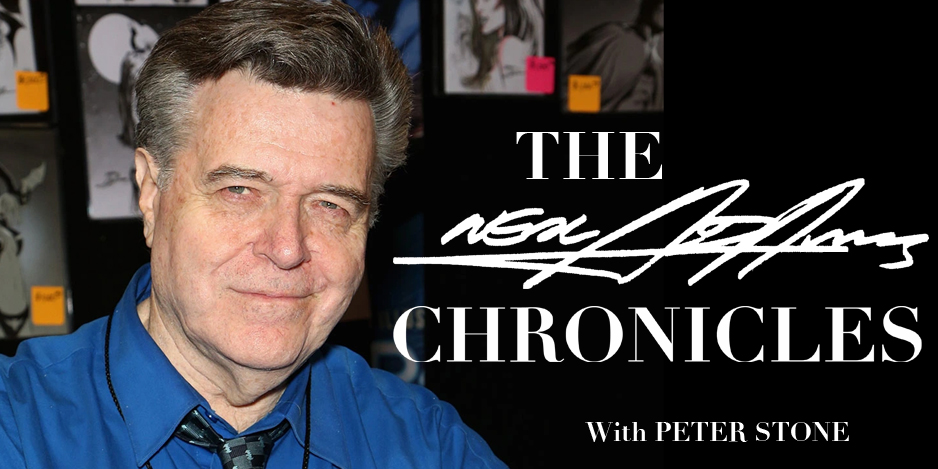
—
Welcome to the first installment of THE NEAL ADAMS CHRONICLES, a new, regular feature about comics’ greatest artist, produced in conjunction with Adams’ family. You can read more about what this is all about over here. (You’ll want to.) The centerpiece of the feature is Peter Stone’s ongoing column about his late father-in-law’s perspectives on art, comics and even entertainment. We kick off below with a look at Adams’ longtime respect and admiration for famed comics writer Bob Haney. Plus, we have a groovy follow-up scheduled for Monday. So, dig this, dig that and rock on. — Dan
—
By PETER STONE
“Pete, do you like Bob Haney’s writing,” Neal asked one day in the days before the blue shirt and cartoon ties. Little did I realize this was another piece of my comic-book education. I was always being blindsided by these little innocuous questions that turned out to be major moments in my understanding of sequential art.
(Just so we all know, the quotes connected to Neal Adams (and myself) are paraphrased for the sake of clarity, excitement and drama. I’ve had this conversation with Neal several times and heard him have it with others, so Neal’s opinions are genuine. )
I responded with, “Sure. I read a ton of Jim Aparo stories and I have those DC Baxter reprints of your work. The ones with the Garcia-Lopez covers.”
“Yeah, they were pretty good covers. Almost as good as mine, right?” he asked with his big, gregarious smile. He knew his covers were the best during those days. Especially the ones where Carmine Infantino did not give him a layout to follow.
“Almost,” I said with a laugh. I learned early on that Jose Luis Garcia-Lopez was a god at Continuity Associates, Neal’s studio that he founded with Dick Giordano. Neal was tremendously happy that Garcia-Lopez took over the role of being the artistic “face” of DC Comics.
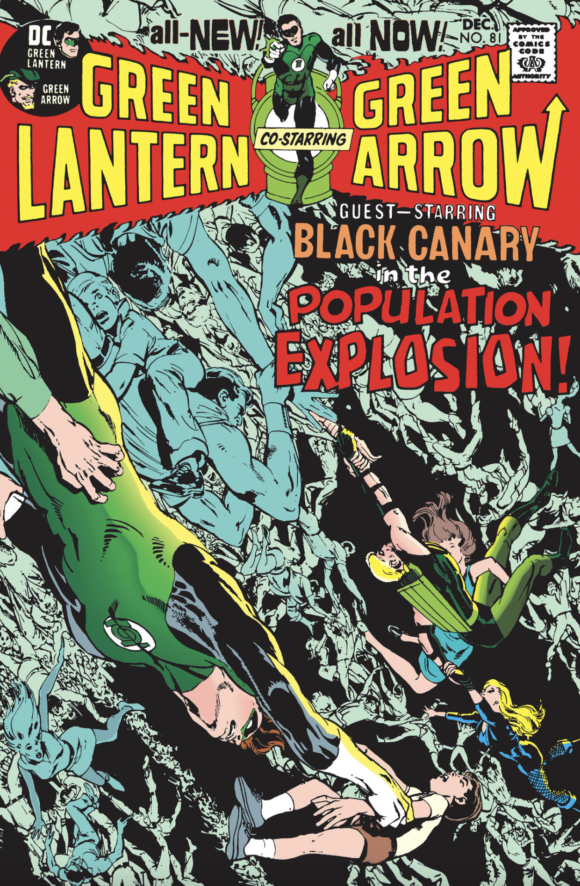
“Most fans think Denny was the best and maybe he gave me enough freedom to do what I wanted, but he was, at heart, a journalist. Denny always approached a story like he was reporting real life. I always felt that I had to pull out my best to make the stories even more exciting. We worked pretty well together and people like it. But, overpopulation was not my favorite concept. (Green Lantern/Green Arrow #81) By that point we had sort of run out of the big concepts. Thankfully, we decided to do the whole Speedy drug thing (Green Lantern/Green Arrow #85 and #86) and I put in those last two or three pages (in Issue #86) which made that story a real human classic.
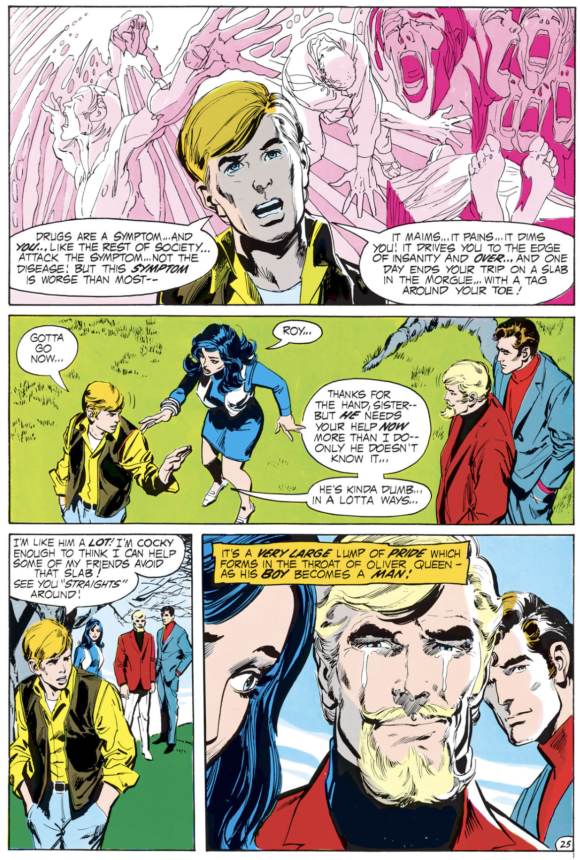
Green Lantern #86. Dick Giordano inks.
“Before Green Lantern and Batman, in a lot of ways, Bob Haney was my favorite writer working at DC Comics. Bob had a great history at DC. He gave me exactly what I needed to save Batman. To make him better.”
“Save Batman? What did you need?” I said, egging him on to tell me the full story. Sure I knew Bob Haney, but Denny was always the default writer when it came to Neal. He did not make it known that Haney was secretly his favorite.
Much to my frustration, someone needed Neal’s attention for a few moments. An advertising instruction or some such nonsense. We were talking about COMICS here! THAT was important. I waited patiently.
When Neal and I used to sit in the Continuity conference room, we would work quietly for hours. I would be writing dialogue, organizing pages of upcoming comics, or doing many of the things that publishing required. Neal would ALWAYS be drawing something. Comics, covers, storyboards, comps, animatics or even finished printed images. Various employees would come in with problems or to check their work with Neal, but there were long time periods of silence broken only by the grinding whir of his pencil sharpener. Then Neal would get bored and start to tell a story.
Working with Neal required that you know the length and breadth of his comic work. You had to understand that he was about 10 years younger and 10 years older than almost everyone else in the business. You had to know that in the 1950s, the Wertham-fueled congressional witch hunt had almost wiped out superheroes. So when Neal presented his portfolio to DC Comics in the late ’50s, he was told that he was wasting his time and that comics would be gone in a year or so. Neal, as we all know, went to Archie and, later, Warren where he turned out a series of brilliant stories in a variety of styles. DC and Batman eluded him.
However, he soon enough got a break at DC, drawing war stories and covers over Carmine Infantino layouts, before getting his first real break as a writer and artist on The Spectre (where he took over from the beloved Murphy Anderson in Issues #2 through #5) and then getting Deadman in Strange Adventures #206 after the first issue by Arnold Drake and Infantino. Neal didn’t write Deadman until near the end (starting with Strange Adventures #212, #213, #215, #216, and Aquaman #50 through #52) and most of the stories frustrated him. He felt the series had devolved into random stories that didn’t tie together. Like a bad TV show. Like the ridiculous Batman TV show. (His opinion… not everyone else’s.)
“You see, the Batman show kept the character alive but it was really just a parody of the real Batman,” Neal said. “Once it became popular, it was a place for stars to appear as costumed clowns and tell some jokes. It wasn’t the Batman I loved, but it affected the comics. Giant pool tables, silly plans and a villain of the month.
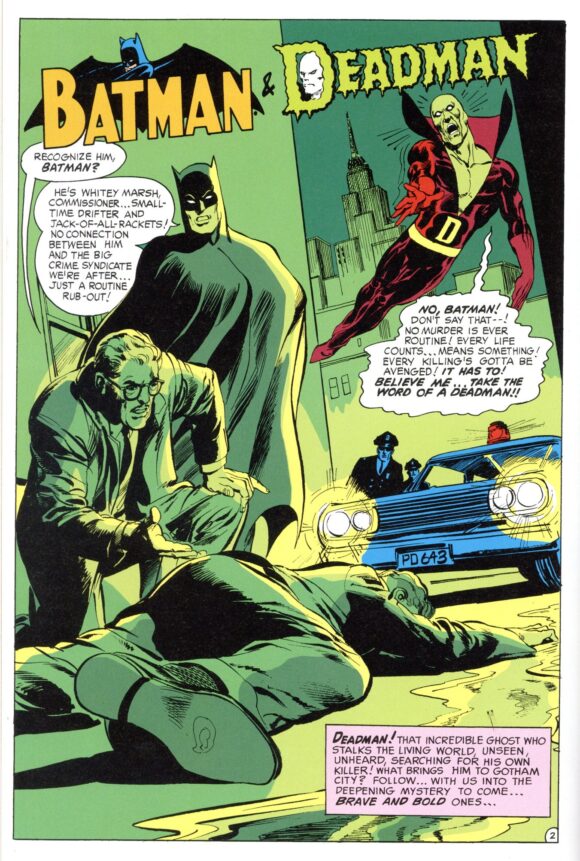
The Brave and the Bold #79
“So when I got The Brave and the Bold series, I was determined to bring Batman back to his roots. The pulp character that Bob Kane…um… ‘created.’ Batman wasn’t supposed to walk down the street during high noon. Batman wasn’t supposed to drive around in a car with a big Bat face on the front. I mean, every criminal would see him coming from a mile away. Bob Haney understood that.
“He would write a scene where Commissioner Gordon and Batman were investigating a murder and most artists would make it daytime. I simply made it nighttime with all these shadows stretching down the street. It was a serious attempt to make it cool and interesting. There’s a scene where a frogman spearguns a guy and I remember hitting him with white highlights so he’s really shadowed. Not that the colorists helped me out too much,” he laughed. (The Brave and the Bold #82.)
During The Brave and the Bold, Haney provided the fans, and Neal, with exactly what a Batman story should be. Some solid action, a good plot, a few twists and turns, and Batman and his co-star doing cool things. It didn’t deal with the problems of the world like the Green Lantern/Green Arrow series.
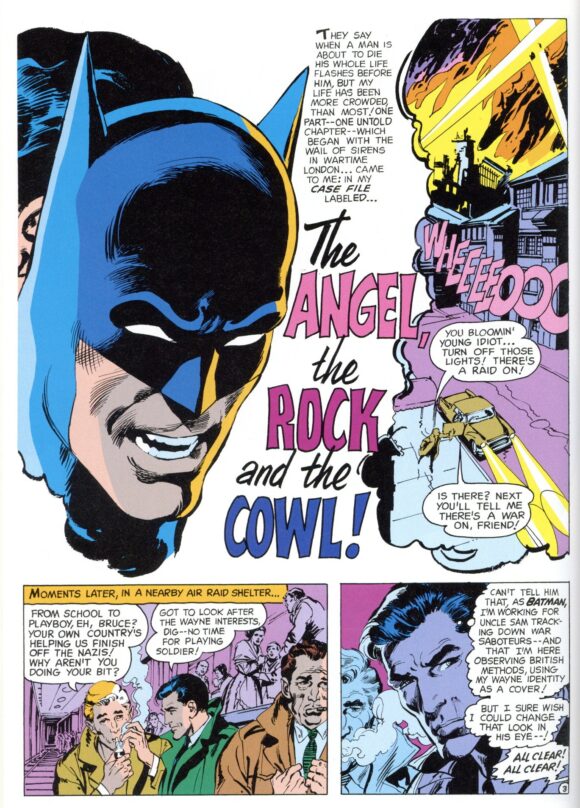
B&B #84
One of the more interesting Haney/Adams combinations was The Brave and Bold #84, “The Angel, The Rock and the Cowl,” featuring the legendary Bob Kanigher/Joe Kubert character, Sgt. Rock. Bruce Wayne is mysteriously transported back to World War II where he encounters Rock and the Combat-Happy Joes of Easy Company. Haney proves he knows his stuff concerning WW II — he was a vet who fought on Okinawa — calling the villain’s plan Operation Barbarian (since there was a real operation called Operation Barbarosa, with Nazi Germany invading the Soviet Union).
Haney also has Bruce Wayne use the fake name Jack Pimpernel. The Scarlet Pimpernel was a masked, sword-wielding hero of 18th century France and was a predecessor to Zorro and possibly the Shadow, and a major influence on a young Stan Lee. The real pleasure of this issue is Neal channeling one of his heros’ art style, Joe Kubert. It’s still Neal, but it has elements of Kubert in the Easy Co. characters. Especially in Neal’s brilliant inking. Joe Kubert even assists in the inking with Neal on one of the pages. Bob Haney gave Neal a chance to work with one of his personal heroes.
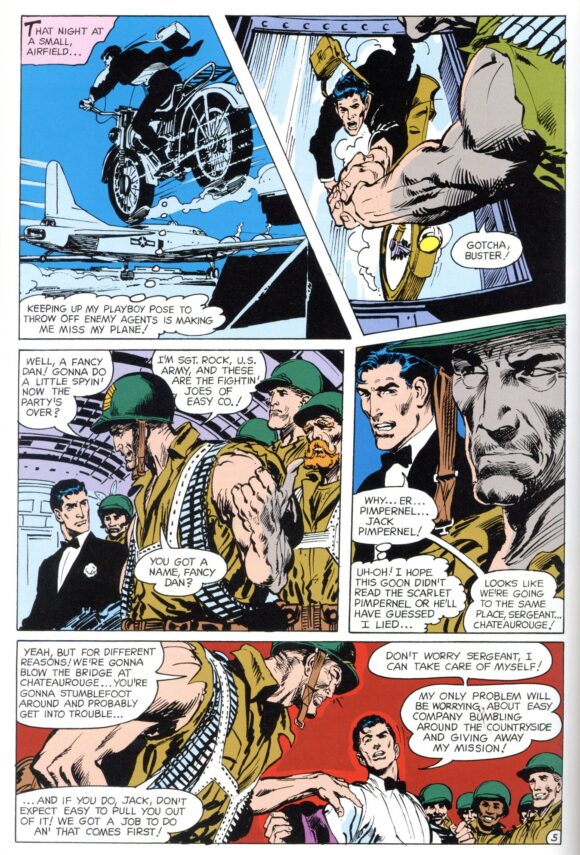
B&B #84
Brave and Bold #84 is a precursor to an Enemy Ace story in Star Spangled War Stories #144 that Neal drew completely in Kubert’s style. Kubert told Neal that the young man had somehow climbed into his head and drawn pages that he had never thought of, but were just like his. Neal could not have been happier.
Neal always felt that Batman was Sherlock Holmes at heart; a character and series of stories that he loved. Haney’s Batman was capable and a master of his physicality. He knew martial arts, boxing, fencing and even driving. He was the best, or close to it, at everything he did. Haney gave him the structure to showcase Batman doing cool stuff while his co-star would do his thing: the Flash, the Creeper, Aquaman, Sgt. Rock, the Teen Titans, and Neal’s redesigned Green Arrow, whose costume captured the heart of every fan who saw it. (The Brave and the Bold #85.) To Neal, Haney understood each one of the co-stars and gave them focus of character.

Neal’s reaction to the Batman TV show was directly related to his Brave and Bold stories with Haney. They had a sense of modernity that most other comics didn’t have. The Batman TV show deepened the public’s perception that comics were silly and melodramatic. Neal had grown up understanding that Batman was a normal man who, through sheer force of will, became the World’s Greatest Detective and perhaps the most dangerous opponent any criminal would face. Neal’s Batman was drawn with anatomy; his muscles real but also not bulbous like a bodybuilder. Most importantly, Neal knew Batman was a DARK NIGHT detective. He didn’t wear heavy boots. He wore ninja-like boots and was as silent as a cool breeze.
So, Haney gave Neal scripts he was excited to read. Haney gave Neal the opportunities he wanted. The opportunity to put Batman at night where cars’ headlights were blinding, the opportunity to draw mysterious gunsels creeping through shadowed alleys and supervillains who had understandable motivations. The very first page of The Brave and the Bold #79 showcased exactly what he wanted. A man flees a hook-handed assassin. Moments later, he is gunned down from behind. Neal would tell me that I had to keep in mind that this was before he was recoloring his and others’ work.
“Green? Did someone think that was the right color for a shadow?” he would rant. “No continuity, no drama, no realism at all. It’s hard to look at. I wish I had the chance to color that one.”
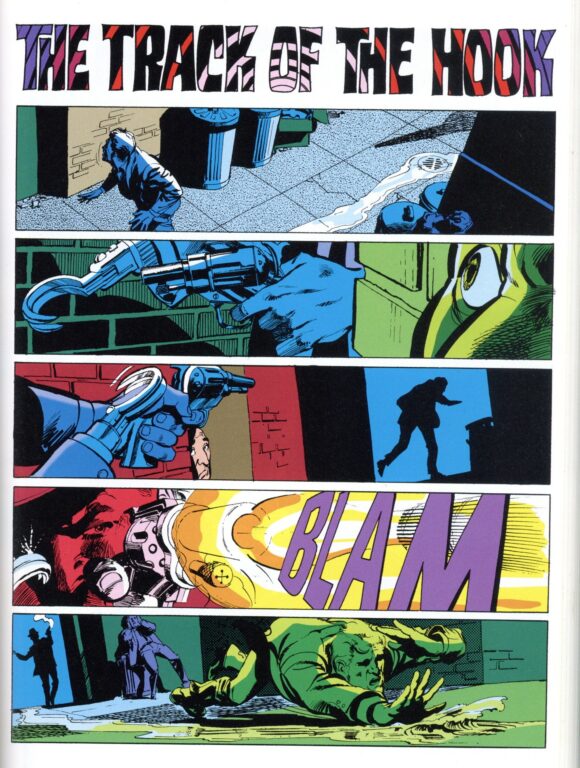
The Brave and the Bold #79
Deadman was the first team-up with Batman. The story features Deadman using his powers to fight Batman; taking over random strangers so Batman never knew where the threat was coming from and eventually forcing the hero to take on the mysterious case of Boston Brand’s death. It relates directly to Neal’s run on Deadman and Haney embraced the ghostly hero’s search for his hook-handed killer. It wasn’t a love story where Deadman had to save a girl from an angry boyfriend. (Strange Adventures #214.) It wasn’t about a biker gang. (Strange Adventures #206.) It wasn’t a case of mistaking a crowbar for a hook hand. (Strange Adventures #210.)
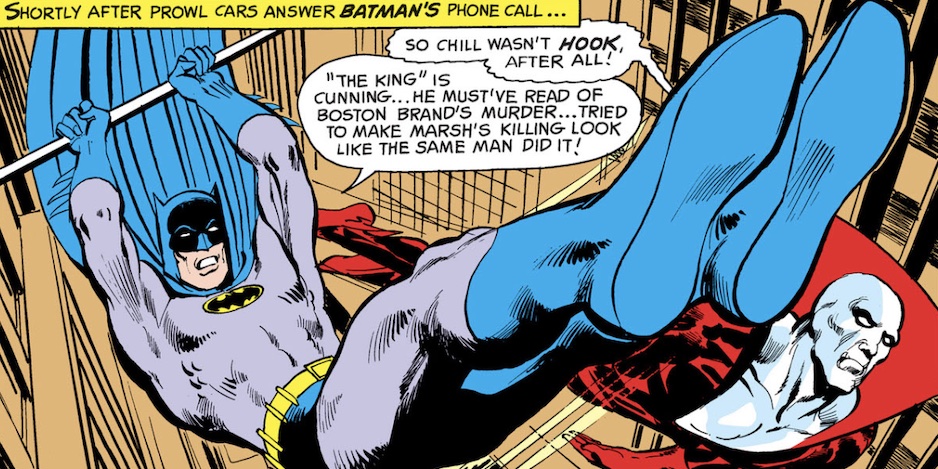
B&B #79
The story was also a transition piece in many ways. Sure, there were criminals and guns and even a sword fight at the end, but the villain wasn’t a “clown” as Neal was often wont to say. He wasn’t a cartoon character with a gimmick. He was an actual criminal. Haney put in enough realistic action for Neal to draw. The sword fight isn’t as dramatic as the later battle in the desert with Ra’s Al Ghul (Batman #244), but it was certainly topical. At the time, martial arts were becoming a very big deal. As was the dialogue. Neal had no problem with timely dialogue. In fact, he enjoyed it. There have been critics who don’t like Haney’s topical dialogue, but Neal totally dug it.
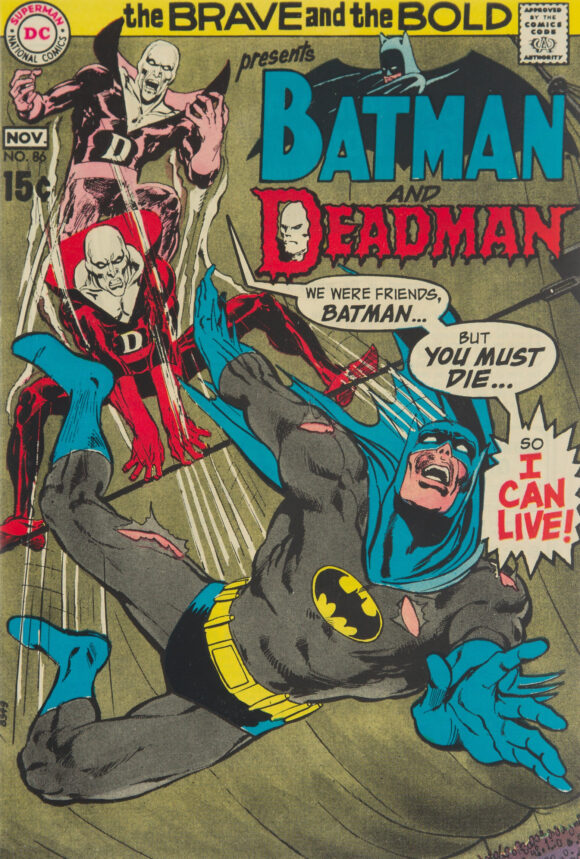
Neal’s next-to-last issue of Brave and Bold was a return to the Batman/Deadman crossover. (The Brave and the Bold #86.) Haney, again handling the writing, used the concepts that Neal was personally writing in his Deadman run. The Sensei, Nanda Parbat and the evil people being contained within the mysterious stronghold in the Himalayas.
Fans may complain that B&B #79 is not the classic Batman that Neal is known for because his ears are shorter and more like the TV show, but Neal’s own inking of his pencils is wonderfully solid. The faces especially are clear and interesting so the art is great, but it certainly helps that the entire story is solid and much better written than some of the other Deadman solo stories.
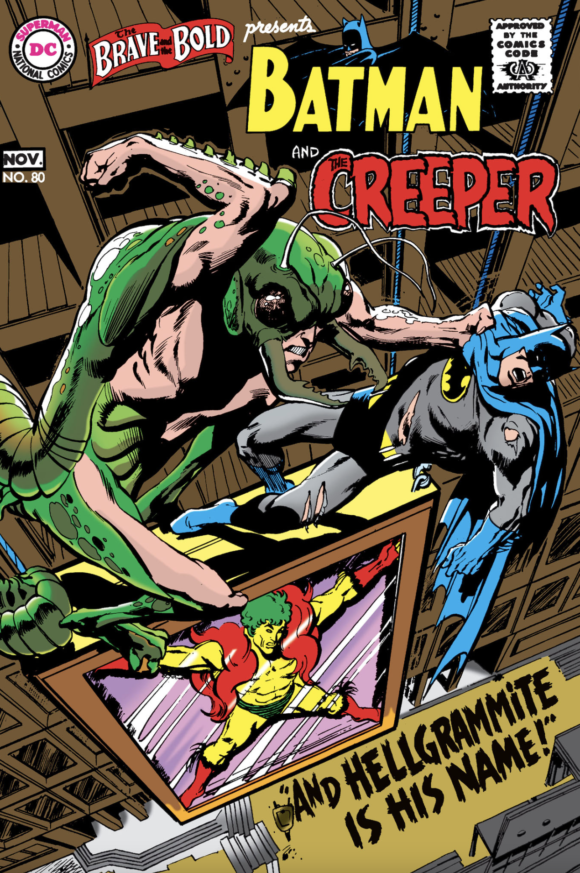
Directly after this issue is one of the craziest team-ups for Batman: The Creeper. (The Brave and the Bold #80.) The villain is Hellgrammite, an insect man who eventually ended up appearing in an episode of the Supergirl TV show. (Someone was smart enough to pull this villain out, dust him off and have him fight the Maid of Might.) But a giant insect guy fighting Batman? Who could Haney throw in to make sense of this lunacy? Well, Steve Ditko’s wacky Creeper, of course.
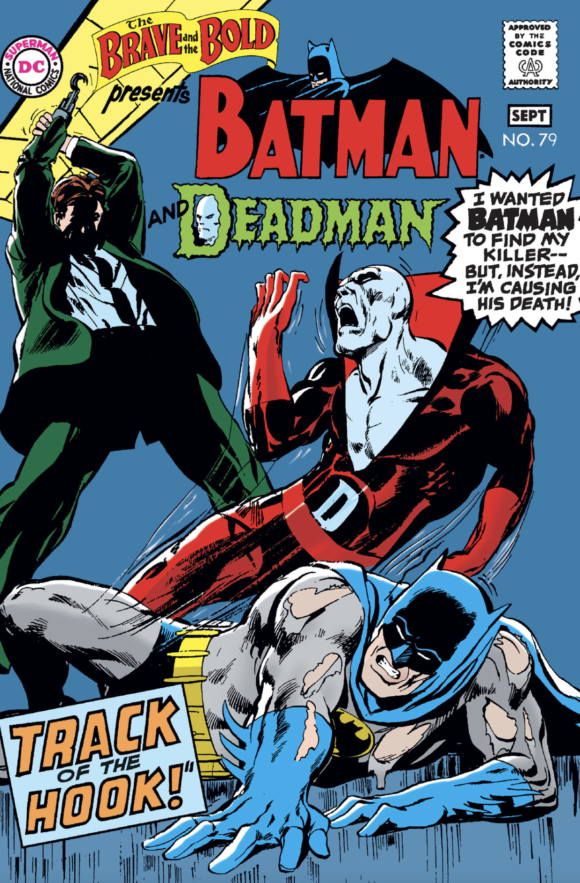
As has been said and written many times, The Brave and the Bold #79 was one of the most important and influential single issues in the past 60 years. It was the second time that Neal Adams drew the iconic character that he would become most associated with – Batman. (The first time was 1968’s World’s Finest #175, which features the greatest way to get into any secret hideout – you stab a giant image of Batman with a knife and say “Die, Batman, Die!!” How awesome is that?)
With B&B #79, Neal was fully invested in drawing his favorite childhood character. It also linked Neal with one of the writers he respected the most – Bob Haney.
—
MORE
— Introducing… THE NEAL ADAMS CHRONICLES. Click here.
— Dig NEAL ADAMS’ Gorgeous Tribute to Jim Lee’s BATMAN and CATWOMAN. Click here.

August 6, 2023
I think I speak for a lot of people who grew up reading Batman in the seventies when I say Brave and Bold was often the best Batman book on the shelves in any given month. The stories were self-contained, imaginative and (under Adams and/or Aparo) beautifully drawn. Yeah, there were odd moments here and there but not necessarily overly odd, especially for a nine to eleven year old comic book reader.
August 8, 2023
Here is an interesting review of Adam’s first Brave and Bold story.
August 8, 2023
Here is an interesting review of Adam’s first Brave and Bold story. https://dailypop.wordpress.com/2011/03/15/batman-and-deadman-team-up-in-a-classic-brave-and-the-bold/
August 11, 2023
I don’t know what comic I traded my best friend with to get the Hellgrammite issue but it was worth it! 50 + years ago and I still remember the artwork, the dialogue (“Come, Mr Tursk! Hellgrammite has need of you!”) and my first introduction to the very cool Creeper! And SJG, I agree with you about B & B!